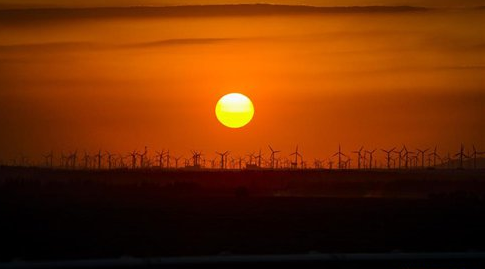
(Photo: Xinhua)
To bacon and tragic Shakespearean princes, Denmark can add a new claim to fame: wind power. Despite being small and only moderately blustery, the Northern European nation is home to the sector's two leading lights - wind farm operator Orsted and turbine maker Vestas Wind Systems, worth $54 billion between them. With climate change inflating the global wind-power market to more than $1 trillion in the next two decades, there's potential for both to get a whole lot bigger.
Denmark's wind supremacy is a vindication of its muscular green lobby and far-sighted industrial policy that awarded the industry just the right level of subsidies. In 1990, Copenhagen was the first European government to set wind energy production targets, and a year later the world's first offshore wind farm was commissioned. By gradually reducing state aid in the mid-1980s from an initial 30 percent of upfront costs, local companies like Vestas - formerly a maker of industrial cranes - were forced to stand on their own feet sooner than international rivals. The $36 billion wind-farm operator Orsted is still 50 percent owned by the state.
That thinking has paid off handsomely. Vestas is now the biggest maker of wind turbines, with a market capitalization of nearly $18 billion - 5 percent of Danish GDP - and an order book backlog that grew 9 billion euros ($9.92 billion) in the last year to 33 billion euros. Furthermore, it is in ruder health than closest rival Siemens Gamesa Renewable Energy. The 8 billion euro Spanish-German outfit had to cut next year's forecast operating margins, now at 5.5 percent to 7 percent, due to pressure from wind-farm operators that are steadily losing subsidies for their electricity. In contrast, Vestas reported operating margins on Thursday of 11.8 percent, up from 9.8 percent a year ago.
Vestas' 2.8 billion euros of net cash at the end of last year is in contrast with Siemens Gamesa's 615 million euros. That leaves it better placed to capture a significant chunk of the $1.2 trillion that the International Energy Agency thinks will be spent on offshore wind in the next two decades. That potential is showing through in Vestas shares, which jumped 12 percent on Thursday to 608 Danish crowns ($89.74) - more than 20 times their value in 2012. After that bump up, Vestas is valued at more than 19 times this year's 740 million euros of forecast net income, compared to Siemens Gamesa's 16 times. Although both stand to gain from the shift from fossil fuels, the wind in the sails of Vestas - and Denmark - looks stronger.


